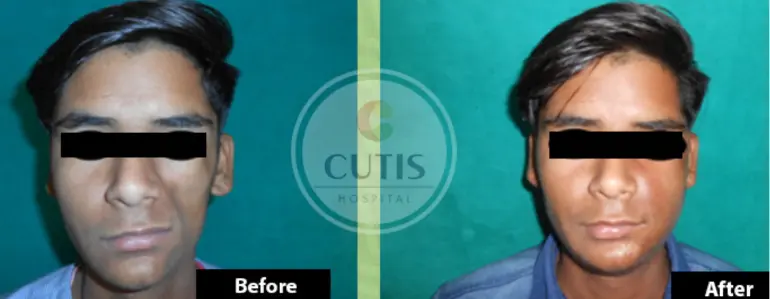Before understanding the treatment involving fat injection, let’s first discuss Romberg’s disease. Also known as Parry Romberg’s disease or hemifacial atrophy, this condition affects half of the face in young individuals, typically between 12 to 25 years of age. In cases where the disease manifests early, it can extend to the scalp, neck, or even the bones of the face and skull. The affected part of the face, particularly the fat and muscles beneath the skin, begins to atrophy (shrink) on its own. This process starts spontaneously and cannot be controlled once it initiates. Although various theories have been proposed, the definite cause of Romberg’s disease remains unknown. Once the atrophy of facial tissues begins, it progresses for about a year or longer and can affect bones as well. Unfortunately, there is no treatment currently available to halt the progression of this disease, but it typically stops on its own over time.
The main challenge in treating Romberg’s disease is that a plastic surgeon cannot attempt to correct facial disfigurement until the disease has stopped progressing. Once the progression ceases, the deformity can be assessed, and a reconstructive plan can be developed. Traditionally, the soft tissue (muscles and fat) deficit was addressed using various types of tissue transferred from the patient’s own body, such as de-epithelialized skin, skin and fat, and different flaps. However, in recent years, autologous fat—fat harvested from the patient’s own body—has become a highly effective alternative for reconstructing soft tissue deficits in patients with Romberg’s disease.
Case Study: Autologous Fat Injection for Romberg’s Disease
Here we present the case of a 19-year-old patient diagnosed with Romberg’s disease. We waited for over a year until the disease had fully burned out. Once it stabilized, we planned the reconstruction using autologous fat injection. Under anesthesia, the patient’s fat was harvested from the abdominal wall. After a process of mechanical preparation, the fat was injected using a special cannula beneath the skin of the affected area on the face.
Immediately after the procedure, both sides of the patient’s face appeared symmetrical, with no visible sign of the previous deficit. However, it is important to note that over 50% of the injected fat typically gets reabsorbed by the body within the next 45 days, making it necessary to repeat the procedure 2-3 times. While the need for multiple sessions can be seen as a downside, this method is very safe and does not pose any long-term issues, even years down the line.
Apart from filling in the atrophied (shrunken) tissues, the injected fat also brings new blood supply to the overlying skin, which greatly improves the luster, texture, and color of the skin. This is a significant advantage because it enhances the patient’s self-confidence, making the overall outcome much more satisfying.
Conclusion
Autologous fat injection is a novel and effective approach to treating soft tissue deficits in patients with Romberg’s disease. While the procedure may require multiple sessions, it offers several advantages, including safety, improved skin texture, and natural-looking results. This treatment not only restores facial symmetry but also boosts the self-esteem of those affected. If you are dealing with Romberg’s disease and are seeking to restore facial harmony, autologous fat injection could be the solution you’ve been looking for.
If you are suffering from Romberg’s disease and want to enhance your facial harmony, please contact us at +91 97259 99526. for more details.

 24 August 2018
24 August 2018 FACE SURGERY
FACE SURGERY 0 Comments
0 Comments
